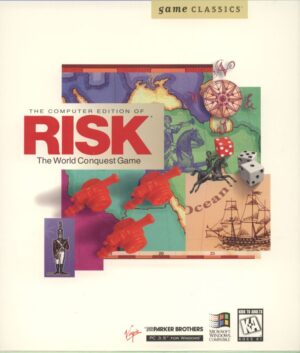Retro Replay Review
Gameplay
The Liberation of Kuwait takes a decidedly unconventional approach to interactivity: once the program is launched, the entire operation unfolds without further player input. Rather than micromanaging units or issuing real-time commands, you become a spectator of a meticulously choreographed military campaign. This hands-off style underscores the overwhelming air superiority of the coalition forces in Operation Desert Storm, illustrating how even a top-tier fighting force like Saddam Hussein’s Republican Guard could be neutralized with superior firepower.
(HEY YOU!! We hope you enjoy! We try not to run ads. So basically, this is a very expensive hobby running this site. Please consider joining us for updates, forums, and more. Network w/ us to make some cash or friends while retro gaming, and you can win some free retro games for posting. Okay, carry on 👍)
Despite the lack of direct control, the game provides a wealth of battlefield data and after-action reports. You can monitor casualty figures, analyze sortie logs, and review satellite imagery that documents the coalition’s advance across the desert. These elements give a sense of depth and authenticity, making gamers feel they are studying an actual military dossier rather than playing a traditional title.
One of the more intriguing gameplay wrinkles is the hidden “dormancy” mechanic. If the software is left untouched for twelve real-world years, it automatically triggers an unlockable mode reminiscent of historical doom simulations like Forbidden.exe or Punishment. This Easter egg adds a layer of mythos around the title, although most players will never wait that long to see it in action.
Graphics
Visually, The Liberation of Kuwait combines low-polygon 3D vistas with period-authentic 2D overlays. Desert landscapes stretch out in muted tans and ochres, punctuated by sparse clusters of palm trees, oil installations, and Iraqi armored convoys. The simplicity of the graphics hearkens back to early ’90s military software, lending the game a retro authenticity that history buffs will appreciate.
Unit models are surprisingly detailed for their era—tank turrets rotate, helicopters hover, and explosions bloom in stylized pixelated fireballs. Static images of coalition command centers and briefing rooms are interspersed between sequences, often accompanied by scanned photographs and declassified documents. While the animation is minimal, these touches help bring the conflict to life without overwhelming the historical tone.
Text overlays and map interfaces are clean and utilitarian, prioritizing clarity over flair. Color-coded movement corridors and strike zones make it easy to follow the campaign’s progression from the Euphrates Valley through Kuwait City. Some may find the lack of flashy visual effects underwhelming, but this deliberate restraint keeps the focus firmly on Cold War–era tactics rather than modern combat spectacle.
Story
At its core, The Liberation of Kuwait offers a straight-forward retelling of Operation Desert Storm’s opening phase. The narrative voiceover and mission briefs emphasize the contrast between public fear of Saddam Hussein’s formidable Republican Guard and the reality of their vulnerability to sustained air assaults. By highlighting the relatively swift Iraqi surrender, the game subverts the “unstoppable tyrant” stereotype popularized by contemporary media.
The title also doesn’t shy away from deeper political context: it notes the coalition’s choice to depose Iraqi forces without toppling Saddam himself, setting the stage for future regional conflicts. Archival speeches, newsreel footage, and declassified government communications are woven into cutscenes, providing insight into the decision-making that shaped the war. This historical framing transforms what could be a sterile simulation into an interactive documentary.
Underlying the serious subject matter is a subtle critique of propaganda—and of war games themselves. By automating the entire campaign, the author seems to ask: if real combat can be reduced to a scripted sequence, what does that say about our understanding of conflict? The optional long-term Easter egg only deepens this question, hinting at perpetual cycles of violence that extend well beyond any single engagement.
Overall Experience
The Liberation of Kuwait is less a traditional wargame and more an immersive historical exhibit. For players seeking fast-paced action or strategic depth, the lack of hands-on engagement may prove disappointing. However, for history enthusiasts and military scholars, the title offers an unparalleled window into the logistics, planning, and political calculus of Desert Storm.
The pacing is deliberate and unhurried, allowing you to absorb each phase of the operation at your own pace. The absence of real-time controls can feel jarring at first, but it soon becomes clear that the game’s true ambition lies in its role as a living archive. Its blend of factual records, visual aids, and ambient audio transports you back to the early ’90s, giving a visceral sense of how coalition commanders viewed the battlefield.
Ultimately, The Liberation of Kuwait stands out as an experimental piece of interactive media. It challenges conventional notions of gameplay and uses its unusual design to comment on the nature of modern warfare. If you’re intrigued by the intersection of gaming, history, and political analysis, this program is a compelling—and sobering—experience.
 Retro Replay Retro Replay gaming reviews, news, emulation, geek stuff and more!
Retro Replay Retro Replay gaming reviews, news, emulation, geek stuff and more!





Reviews
There are no reviews yet.